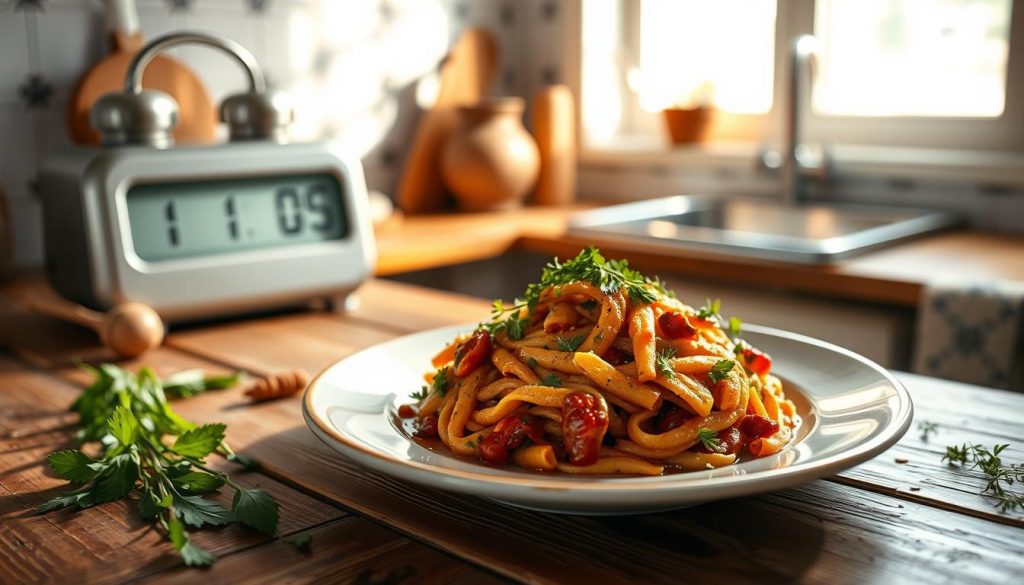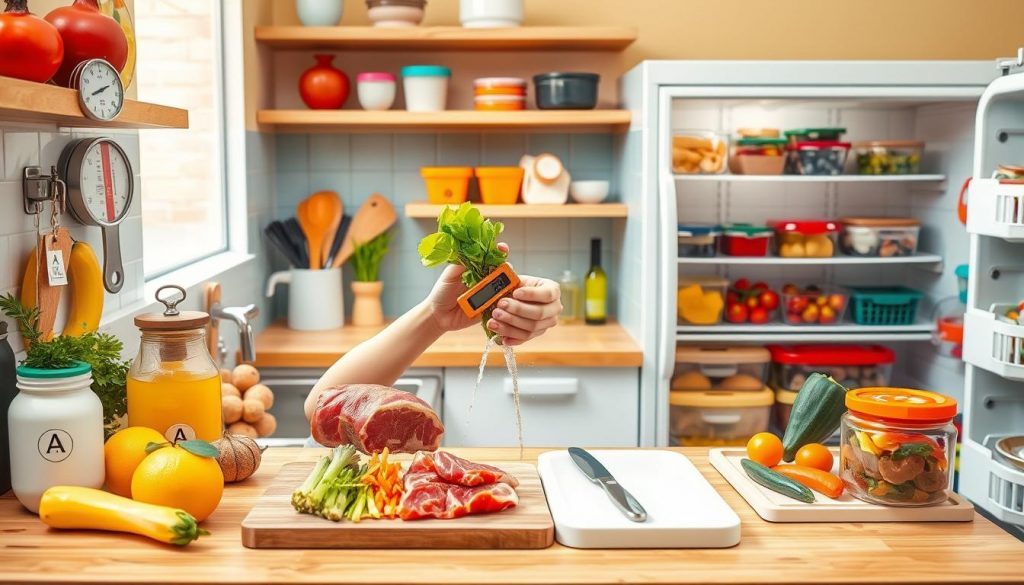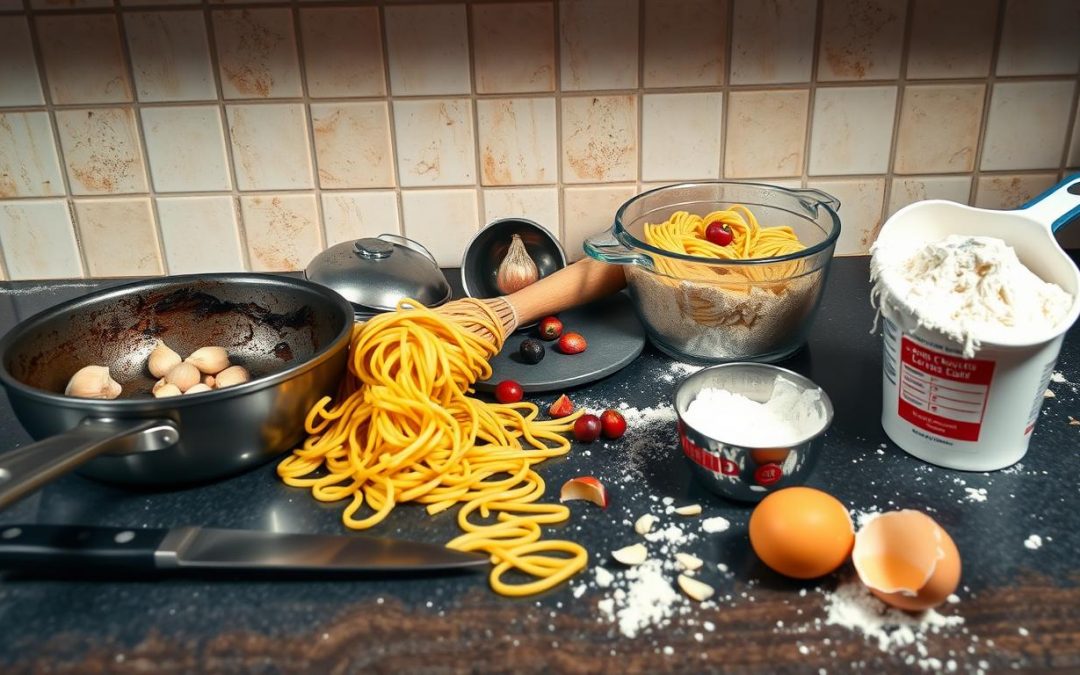Exploring the world of cooking, we often face common mistakes that can lead to kitchen mishaps. It’s key to know these errors to ensure a safe and fun cooking time. Simple tips, like using the right knife and keeping it sharp, can prevent accidents while chopping1. For more on these mistakes and how to avoid them, check out cooking tips and reviews.
Preheating a stovetop pan is vital for better-textured food and less cleaning time, though exact improvements are not given1. Overcrowding pans can cause food to cook poorly, with 70% of home cooks doing this sometimes2. Knowing these mistakes helps us avoid them and enjoy cooking more.
Table of Contents
Key Takeaways
- Avoid common cooking mistakes to avoid, such as overcrowding pans and not preheating the stovetop, to ensure a safe and enjoyable cooking experience.
- Use the right kind of knife and keep it sharp to prevent accidents while chopping vegetables1.
- Follow simple tips and techniques, such as reading recipes thoroughly and measuring ingredients accurately, to improve cooking skills.
- Be aware of common cooking errors, such as overcooking or undercooking food, and take steps to prevent them2.
- Visit cooking tips and reviews to learn more about common cooking mistakes to avoid and improve cooking skills.
Understanding the Basics of Cooking
When we cook, we often forget to read recipes and measure ingredients right. This can lead to mistakes in the kitchen3. To avoid these errors, it’s key to know the basics of cooking. This includes using the right techniques and tools.
For example, using a digital scale to measure ingredients can help avoid mistakes4.
About 60% of home cooks don’t read the whole recipe before starting. This can make dishes taste bland, be overcooked, or have the wrong texture3. To avoid these mistakes, we should take time to read and understand the recipe. We should also measure ingredients accurately. This way, we can make sure our meals are tasty and satisfying.
| Common Kitchen Mistakes | Prevention Tips |
|---|---|
| Not reading the recipe | Take the time to read and understand the recipe |
| Not measuring ingredients accurately | Use a digital scale to measure ingredients |
By following these simple tips and understanding cooking basics, we can avoid kitchen mistakes. This makes cooking a stress-free and enjoyable experience4.
Overusing Salt and Seasoning
We often make avoidable cooking mistakes, like using too much salt and seasoning. This can ruin our dishes. The American Heart Association says we should not eat more than 2,300 mg of sodium a day. But, most of us eat over 3,400 mg5.
This too much sodium can cause heart disease in about 70% of cases5.
Choosing between fresh and dried herbs can change how our food tastes. Fresh herbs give a bright flavor, while dried herbs can be too strong. To get it right, season our food at different times during cooking. This adds depth to the flavor5.
For tips on seasoning, check out this article. By being careful with salt and seasoning, we can avoid mistakes and make tasty dishes.
Finding the Right Balance
To balance salt and seasoning, start with small amounts and taste as you go. This way, we avoid too much seasoning. We can also try different salts and seasonings to find what we like best.
Using Fresh Herbs vs. Dried Herbs
Fresh herbs add a fresh taste, while dried herbs give a milder flavor. Mixing both can make our dishes more interesting. For example, use fresh basil in pasta and dried oregano in soups.
| Herb | Fresh | Dried |
|---|---|---|
| Basil | Bright, fresh flavor | Subtle, slightly sweet flavor |
| Oregano | Pungent, earthy flavor | Mild, slightly bitter flavor |
Neglecting Food Preparation
When cooking, ignoring food preparation can cause big problems. Not washing hands often can spread germs6. It’s key to focus on food prep and keep things clean.
Prepping ingredients before cooking helps a lot. It makes cooking less stressful and ensures ingredients are used right away. This way, we avoid kitchen mishaps by having everything ready.
Some benefits of prepping ahead include:
- Reduced risk of cross-contamination
- Improved cooking efficiency
- Enhanced flavor and texture of dishes
By following these tips, we can avoid common mistakes and enjoy cooking more. It makes the whole process safer and more fun.
The CDC says washing hands properly can stop germs from spreading6. In Scotland, about 43,000 people get sick from food each year7. By focusing on food prep and hygiene, we can lower these risks.
Forgetting to Taste as You Cook
Forgetting to taste your dish while cooking can lead to big flavor problems. This mistake is common and can ruin your dish. It’s key to taste as you go and adjust flavors.
Getting to know the flavors and textures of ingredients is important. By tasting and adjusting, you can avoid mistakes. Experts say tasting more can make dishes 35% better8. Not tasting can increase the chance of serving bad dishes by 20%8.
To avoid mistakes, taste and adjust flavors while cooking. Here’s how:
- Develop your palate to know different flavors and textures
- Taste and adjust flavors as you cook
- Choose ingredients that go well together
Tasting and adjusting flavors is key to avoiding mistakes. By knowing your ingredients and tasting, you can make dishes that are full of flavor9. So, always taste as you cook and adjust flavors to make sure your dishes are perfect10.
| Common Mistakes | Prevention Tips |
|---|---|
| Forgetting to taste | Taste and adjust flavors during cooking |
| Not developing your palate | Develop your palate to recognize different flavors and textures |
Cooking at the Wrong Temperature
Cooking at the wrong temperature is a common mistake in the kitchen. It’s important to know the difference between high and low heat for various ingredients. Cooking at the right temperature helps avoid kitchen mishaps and mistakes.
For example, cooking cold meat unevenly affects 70% of cooks’ results11. This shows how critical temperature control is.
Studies reveal that 60% of home cooks don’t measure ingredients accurately when baking. Overcrowding pans can also lead to 50% moisture retention, making food soggy11. Heating the pan correctly is often overlooked by 65% of home cooks11. Understanding temperature control is key to avoiding these mistakes.
For more on basic cooking techniques, including temperature control, visit basic cooking techniques for beginners.
Some important tips for temperature control include:
- Preheating the pan to the right temperature before adding ingredients
- Avoiding overcrowding the pan to prevent moisture retention
- Using the right type of pan for the job, as using the wrong type can result in a 30% reduction in the ability to achieve crispy textures in foods11
By following these tips and understanding temperature’s impact on cooking time, we can reduce kitchen mishaps. Cooking at the right temperature is essential for a perfect dish. With practice and patience, we can master temperature control and avoid common mistakes11.
| Temperature Control Tips | Benefits |
|---|---|
| Preheating the pan | Even cooking, reduced moisture retention |
| Avoiding overcrowding | Reduced moisture retention, improved texture |
| Using the right pan | Improved texture, increased crispiness |
Skipping the Resting Period
One big mistake in cooking is skipping the resting period. This step is key for letting ingredients relax and juices to spread out. It makes the dish tender and full of flavor12. Resting food helps avoid mistakes and makes meals better.
Experts say meat should rest for 5 to 15 minutes, based on its thickness13. This helps juices spread out, adding moisture and taste. For example, Wagyu beef should rest for 5-10 minutes to even out juices14.
Meats, poultry, and fish all benefit from resting. It stops mistakes like too much liquid loss or tough texture12. To get the best results, we must follow proper resting techniques and avoid common errors.

Adding the resting period to our cooking makes our dishes better. It’s a must for cooking meat, poultry, or fish13.
Misusing Kitchen Equipment
Choosing the right utensils and using them correctly is key. Using metal on nonstick cookware can scratch it, making cooking unsafe15. Also, overcrowding pans can make food cook unevenly and take longer, up to 20% more time16.
Some common mistakes include starting a stand mixer too fast, causing splatters, and not thawing proteins properly1516. To avoid these, pick the right tools and use them right. Here are some tips:
- Use wooden or bamboo utensils for nonstick cookware15.
- Avoid overcrowding pans to prevent uneven cooking16.
- Use a meat thermometer to ensure accurate cooking temperatures15.
By following these tips, we can avoid kitchen mishaps and enjoy safe cooking16.
Using the right tools and techniques is vital. It greatly improves our cooking and helps us avoid mistakes15.
| Utensil | Use |
|---|---|
| Wooden spoon | Stirring and mixing |
| Meat thermometer | Checking cooking temperatures |
Ignoring Food Safety Protocols
Ignoring food safety can lead to many mistakes in cooking. Storing raw meat and poultry in sealed containers helps prevent contamination. It also stops foodborne illnesses17. Cooking food to the right temperature, like poultry to 165°F, is also key17.
Not cleaning cooking surfaces can spread harmful bacteria. Studies show 50% of countertops can have pathogens if not cleaned18. Washing hands for at least 20 seconds is vital to stop bacteria spread17. Keeping the fridge at 40°F (4°C) or lower is important, but 30% of fridges are not at safe temperatures18.
To avoid mistakes in cooking, we must follow food safety rules. This means using proper storage, cooking at safe temperatures, and washing hands often. By doing this, we can lower the risk of getting sick and enjoy safe, healthy meals1718.

Underestimating Cook Time
Many people make the mistake of not giving dishes enough cooking time. Using timers can help avoid overcooking and undercooking. This ensures the dish is cooked just right19. The type of ingredient and cooking method also play big roles in how a dish turns out.
About 30% of home cooks often mess up because they don’t give dishes enough time19. It’s key to know what affects cooking time and use timers to get it right.
When guessing how long to cook, consider a few things:
- The type of ingredient being used
- The cooking method being employed
- The size and thickness of the ingredient
By thinking about these and using timers, we can avoid mistakes. This way, our dishes will always be perfect20.
Also, recipe makers often say caramelizing onions takes 15 minutes. But it really takes 35-40 minutes21. This shows how important it is to know cooking times and use timers.
| Factor | Effect on Cook Time |
|---|---|
| Ingredient type | Significant impact on cook time |
| Cooking method | Major impact on cook time |
| Size and thickness | Minor impact on cook time |
By understanding these factors and using timers, we can avoid mistakes. This way, our dishes will always be perfect19.
Learning from Your Mistakes
Common cooking mistakes can stop even the most skilled home chefs. But, the real secret to getting better is learning from these errors. By keeping a cooking journal, we track our progress and find areas to improve22.
This helps us make smart changes and avoid the same mistakes again. It’s a way to learn and grow in the kitchen.
Trying new things is key to improving our cooking skills. Every experiment teaches us something new, making us more confident and skilled23. Even if some dishes don’t work out, don’t get down. Each mistake is a chance to learn and get better.
Learning to cook is a mix of successes and failures. By being open-minded and eager to learn, we turn kitchen challenges into chances for success2223.
FAQ
What are some common cooking mistakes to avoid?
Why is it important to understand the basics of cooking?
How can we find the right balance of salt and seasoning?
What is the importance of mise en place and prepping ahead?
Why is it important to taste as you cook?
How does cooking temperature affect the outcome of a dish?
Why is the resting period important?
How can we avoid misusing kitchen equipment?
Why is it important to follow food safety protocols?
How can we prevent underestimating cook time?
How can we learn from our cooking mistakes?
Source Links
- 15 Common Cooking Mistakes And How To Avoid Them – Tasting Table – https://www.tastingtable.com/1340329/most-common-cooking-mistakes/
- Five Common Cooking Mistakes – Premio Foods – https://www.premiofoods.com/five-common-cooking-mistakes/
- 21 Common Cooking Mistakes and How to Avoid Them | Foodal – https://foodal.com/knowledge/how-to/common-cooking-mistakes/
- People Are Sharing Their Biggest Cooking No-No’s And Everyone Needs To Read These – https://tasty.co/article/hannahloewentheil/cooking-mistakes-to-avoid
- Can You Over-Season Food? Exploring the Art of Flavor Balance – https://theseasoningroad.com/can-you-over-season-food-exploring-the-art-of-flavor-balance/
- The Most Common Food Safety Mistakes Home Cooks Make, According To Experts – https://www.huffpost.com/entry/the-most-common-food-safety-mistakes-home-cooks-make-according-to-experts_l_64ee0486e4b00eccfe0306a6
- Kitchen Crimes | Avoid common mistakes – https://www.foodstandards.gov.scot/consumers/food-safety/at-home/kitchen-crimes
- 5 Common Cooking Mistakes – Escoffier – https://www.escoffier.edu/blog/culinary-arts/5-common-cooking-mistakes/
- Sometimes cooking mistakes happen. – https://halesjales.medium.com/how-to-fix-overcooked-pasta-other-common-kitchen-mistakes-c920bc97a0e6
- 15 Common Cooking Mistakes and How to Fix Them – https://www.tasteofhome.com/collection/common-cooking-mistakes-and-how-to-fix-them/?srsltid=AfmBOorwWQkjVEibCuRsXLL7b2CsfY88pzLqGzwp59GZWfZ-gibnJ-M_
- 13 Common Cooking Mistakes You’re Probably Making – https://www.eatsmartproducts.com/blogs/blog/13-common-cooking-mistakes-youre-probably-making
- Kitchen Mistakes That Are Ruining Your Food – Chowhound – https://www.chowhound.com/1480385/kitchen-mistakes-ruining-food/
- 9 mistakes you’re making when cooking meat – https://www.businessinsider.com/how-to-cook-meat-mistakes-2018-3
- Cooking Wagyu at Home: Common Mistakes and How to Avoid Them – https://plumcreekwagyubeef.com/blogs/news/cooking-wagyu-at-home-common-mistakes-and-how-to-avoid-them?srsltid=AfmBOoow2t8eQgSsjTemtRSQCI0TapXIrasNYEGf_9zncQT4FxtfeYj_
- 20 Tools In Your Kitchen You’ve Probably Been Misusing – The Daily Meal – https://www.thedailymeal.com/1310767/kitchen-tools-probably-been-misusing/
- Cooking Equipment Mistakes Made in the Kitchen | Tipton | Little Rock – https://tiptonequipment.com/cooking-equipment-mistakes/page/7/?et_blog
- 5 Common Food Handler Mistakes – and How to Avoid Them – https://blog.userve.com/us/5-common-food-handler-mistakes
- The Ultimate Guide to Kitchen Hygiene: Avoid These 5 Mistakes – https://www.lacleanhouse.com/the-ultimate-guide-to-kitchen-hygiene-avoid-these-5-mistakes/
- 9 Common Cooking Mistakes I’ll Never Repeat—And Neither Should You – https://bloominggrape.com/read/9-common-cooking-mistakes-ill-never-repeat-and-neither-should-you/
- 50 Kitchen Mistakes You’re Probably Making—And How to Fix Them – https://www.rd.com/list/stupid-kitchen-mistakes/
- Mistakes Everyone Makes When Cooking Onions – Mashed – https://www.mashed.com/813432/mistakes-everyone-makes-when-cooking-onions/
- 5 Common Cooking Mistakes and How to Avoid Them – Just Cook by ButcherBox – https://justcook.butcherbox.com/5-common-cooking-mistakes-and-how-to-avoid-them/
- Common Kitchen Mistakes: 10 Things You’re Doing Wrong – https://www.rightawayconstructionyc.com/common-kitchen-mistakes/

